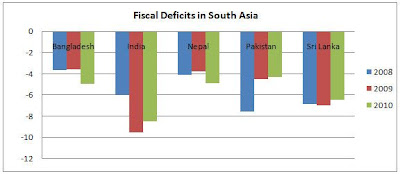Dipak Dasgupta, Lead Economist for South Asia at the World Bank lists four reasons that have helped South Asia's growth rate from plunging down drastically as a result of the global economic crisis, which took South Asia’s growth down by about 3 percentage points (from 8.6% in 2007 to 5.6% in 2009). The World Bank expects GDP growth to recover to nearly 7 percent per annum on average in 2010-2011.
1. Remittances held up much stronger in South Asia than in other regions. In Nepal, the reliance on remittances is the highest, and without these flows, growth in consumption would have collapsed.
2. The resilience of some key export-oriented sectors also helped. Garments in Bangladesh and IT software exports from India, for instance, have held up relatively well.
3. FDI inflows to South Asia suffered a decline during the peak crisis period but have since picked-up sharply in India, Pakistan and Sri Lanka.
4. Policy responded early in the crisis, helped by domestic factors such as the pre-election fiscal spending in India. The size of fiscal stimulus announced was over 3 percentage points of GDP in India and significant also in Bangladesh. Interest rates were lowered sharply in most South Asian countries.
Gupta argues that the region faces two big challenges: food price inflation and fiscal deficits.
Rather than lumping all South Asian countries in the same basket (because high growth from three countries among eight in South Asia jacks up the regional average), there is a need to differentiate the countries into two blocs: high growth countries (India, Bangladesh and Bhutan) and low growth countries that suffer from instability (Pakistan, Nepal, Sri Lanka, and Afghanistan). This way it is easier and accurate to get a clear picture of each country’s constraints on growth, business environment, macroeconomic stability, institutions, governance structure, and bureaucracy . This WB blog post does take a differential look as required, which is not common among South Asian analysts (who actually exclusively look at India and Pakistan and refer it as South Asia; there are six other countries that are member of SAARC!)
Anyway, below are trend of some economic indicators for Nepal (compared with South Asian average).
